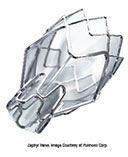Zephyr® Endobronchial Valve Procedure for Severe COPD/Emphysema
What is the Zephyr Valve Treatment?
If you have severe COPD or emphysema, Zephyr Valve treatment may be able to help improve your breathing and overall quality of life. Zephyr Valve implants, an alternative to more invasive traditional lung volume reduction surgery, are designed to fit in the airways of the lungs during a minimally invasive bronchoscopy procedure (no incisions or cutting required).
Who is the Zephyr Valve for?
Generally, you should be evaluated for Zephyr Valve treatment if you:
- Have a confirmed diagnosis of COPD or emphysema
- Have to stop to catch your breath often, even when taking your medication as directed
- Have reduced lung function
These are general criteria, but only a Zephyr Valve trained physician can determine if you are a candidate.
What are the Benefits of Zephyr Valves?
 In clinical studies patients treated with Zephyr Valves have been shown to:
In clinical studies patients treated with Zephyr Valves have been shown to:
- Breathe easier
- Be more active
- Enjoy an improved quality of life
How does the Procedure Work?
If you have severe COPD/emphysema you may struggle to catch your breath while doing everyday tasks. This is because the damaged parts of your lungs have lost their ability to release trapped air and have become overinflated. Zephyr Valves are tiny, one-way valves that allow the trapped air to be exhaled from the lungs and prevent more air from becoming trapped there. This helps patients breathe better and do more.

What to Expect During the Procedure?
Zephyr Valves are placed during a procedure that does not require any cutting or incisions. A typical Zephyr Valve procedure looks like this:
Step 1 – The doctor will give you medicine to make you sleepy.
Step 2 – A small tube with a camera, called a bronchoscope, will be inserted into your lungs through your nose or mouth.
Step 3 – During the procedure your doctor will place Zephyr Valves in your airways. The average number of valves is four, however the number of valves placed will depend on the individual anatomy of your airways and physician discretion.
Step 4 – You will stay in the hospital for a minimum of three nights. Some patients who experience a complication may be required to stay longer.
Step 5 – After the procedure, you will continue to use the medicines that your doctor has prescribed for your condition.
Bronchoscopic Lung Volume Reduction at Guthrie
Guthrie is proud to offer bronchoscopic lung volume reduction (BLVR), providing breathing relief and improvd quality of life for those suffering from chronic COPD/emphysema. Our team of highly skilled Pulmonology providers has been trained specifically for this breakthrough, game-changing treatment, meant to change and save lives. Our goal is to help your condition improve and get you back to doing what you love.
How do I schedule a consultation to see if I am a candidate for the Zephyr Valves?
For more information, please contact the Guthrie Sayre Pulmonology office direct at 570-887-2847 and choose option 3.
To learn more about the Zephyr Valve technology, please visit to uspatients.pulmonx.com.
1 Criner G et al. Am J Respir Crit Care Med. 2018; 198 (9): 1151–1164.


